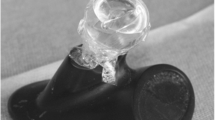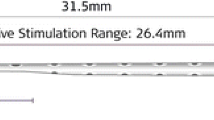Abstract
Introduction
The opening of the round window and the insertion of the electrode array into the scala tympani during cochlear implant surgery can lead to a pressure shock of the delicate inner ear structures. By filling the tympanic cavity with Ringer Solution during these surgical steps (underwater technique), the hydrostatic pressure of the fluid acts as a smooth pressure stabilizer, avoiding a pressure shock of the inner ear structures. The aim of this retrospective study was to present long-term results of this new method of cochlear implantation in underwater technique.
Methods
Altogether, 47 implantations in 43 patients with residual hearing at the frequencies 250, 500 and 1000 Hz in the unaided preoperative pure tone audiometry were included. A cochlear implantation via round window with a conventional full-length electrode was performed in underwater technique. Changes of residual hearing 7 weeks and 24 months after surgery were analyzed.
Results
Overall postimplant hearing preservation 7 weeks after implantation was achieved in 22 ears (47%). Subsequent follow-up was performed on average 24 months after surgery (range 12 months–4.2 years) in all patients. At this late postoperative evaluation, preservation of hearing was recorded in 18 ears (38%). Neither the follow-up time nor the type of electrode had a significant impact on the postoperative hearing loss.
Conclusion
The underwater technique is an atraumatic cochlear implantation technique with hearing preservation rates comparable to results in literature and a very small hearing preservation decline rate over time even when using full-length CI electrodes.



Similar content being viewed by others
References
Hodges AV, Schloffman J, Balkany T (1997) Conservation of residual hearing with cochlear implantation. Am J Otol 18:179–183
von Ilberg CA, Baumann U, Kiefer J et al (2011) Electric-acoustic stimulation of the auditory system: a review of the first decade. Audiol Neuro-otol 16(Suppl 2):1–30. https://doi.org/10.1159/000327765
Gifford RH, Dorman MF, Skarzynski H et al (2013) Cochlear implantation with hearing preservation yields significant benefit for speech recognition in complex listening environments. Ear Hear 34:413–425. https://doi.org/10.1097/AUD.0b013e31827e8163
Gifford RH, Dorman MF, Brown CA (2009) Psychophysical properties of low-frequency hearing: implications for perceiving speech and music via electric and acoustic stimulation. In: Cochlear implants and hearing preservation. KARGER, Basel, pp 51–60
Dalbert A, Huber A, Baumann N et al (2016) Hearing preservation after cochlear implantation may improve long-term word perception in the electric-only condition. Otol Neurotol 37:1314–1319. https://doi.org/10.1097/MAO.0000000000001193
Carlson ML, Driscoll CLW, Gifford RH et al (2011) Implications of minimizing trauma during conventional cochlear implantation. Otol Neurotol Am Neurotol Soc Eur Acad Otol Neurotol 32:962–968. https://doi.org/10.1097/MAO.0b013e3182204526
D’Elia A, Bartoli R, Giagnotti F, Quaranta N (2012) The role of hearing preservation on electrical thresholds and speech performances in cochlear implantation. Otol Neurotol 33:343–347. https://doi.org/10.1097/MAO.0b013e3182487dbb
Kuang H, Haversat HH, Michaelides EM (2015) Impairment of caloric function after cochlear implantation. J Speech Lang Hear Res 58:1387. https://doi.org/10.1044/2015_JSLHR-H-15-0010
Bas E, Dinh CT, Garnham C et al (2012) Conservation of hearing and protection of hair cells in cochlear implant patients’ with residual hearing. Anat Rec Adv Integr Anat Evol Biol 295:1909–1927. https://doi.org/10.1002/ar.22574
Friedland DR, Runge-Samuelson C (2009) Soft cochlear implantation: rationale for the surgical approach. Trends Amplif 13:124–138. https://doi.org/10.1177/1084713809336422
Roland PS, Wright CG (2006) Surgical aspects of cochlear implantation: mechanisms of insertional trauma. Adv Oto-Rhino-Laryngol 64:11–30. https://doi.org/10.1159/000094642
Todt I, Basta D, Ernst A (2008) Does the surgical approach in cochlear implantation influence the occurrence of postoperative vertigo? Otolaryngol Head Neck Surg 138:8–12. https://doi.org/10.1016/j.otohns.2007.09.003
Wilson BS, Dorman MF (2008) Cochlear implants: current designs and future possibilities. J Rehabil Res Dev 45:695–730
Lenarz T, Pau H-W, Paasche G (2013) Cochlear implants. Curr Pharm Biotechnol 14(1):112–123
Miranda PC, Sampaio ALL, Lopes RAF et al (2014) Hearing preservation in cochlear implant surgery. Int J Otolaryngol 2014:468515. https://doi.org/10.1155/2014/468515
Wanna GB, O’Connell BP, Francis DO et al (2017) Predictive factors for short- and long-term hearing preservation in cochlear implantation with conventional-length electrodes. Laryngoscope. https://doi.org/10.1002/lary.26714
Causon A, Verschuur C, Newman TA (2015) A retrospective analysis of the contribution of reported factors in cochlear implantation on hearing preservation outcomes. Otol Neurotol Am Neurotol Soc Eur Acad Otol Neurotol 36:1137–1145. https://doi.org/10.1097/MAO.0000000000000753
Suhling M-C, Majdani O, Salcher R et al (2016) The impact of electrode array length on hearing preservation in cochlear implantation. Otol Neurotol 37:1006–1015. https://doi.org/10.1097/MAO.0000000000001110
Eshraghi AA, Van De Water TR (2006) Cochlear implantation trauma and noise-induced hearing loss: apoptosis and therapeutic strategies. Anat Rec Part A Discov Mol Cell Evol Biol 288A:473–481. https://doi.org/10.1002/ar.a.20305
Fayad JN, Makarem AO, Linthicum FH (2009) Histopathologic assessment of fibrosis and new bone formation in implanted human temporal bones using 3D reconstruction. Otolaryngol Head Neck Surg 141:247–252. https://doi.org/10.1016/j.otohns.2009.03.031
Ward BK, Agrawal Y, Hoffman HJ et al (2013) Prevalence and impact of bilateral vestibular hypofunction: results from the 2008 US National Health Interview Survey. JAMA Otolaryngol Head Neck Surg 139:803–810. https://doi.org/10.1001/jamaoto.2013.3913
Kluenter H-D, Lang-Roth R, Beutner D et al (2010) Postural control before and after cochlear implantation: standard cochleostomy versus round window approach. Acta Otolaryngol 130:696–701. https://doi.org/10.3109/00016480903373732
Fettiplace R, Hackney CM (2006) The sensory and motor roles of auditory hair cells. Nat Rev Neurosci 7:19–29. https://doi.org/10.1038/nrn1828
Anagiotos A, Beutner D, Gostian A-O et al (2016) Insertion of cochlear implant electrode array using the underwater technique for preserving residual hearing. Otol Neurotol 37:1. https://doi.org/10.1097/MAO.0000000000000989
Hüttenbrink KB (1988) The mechanics of the middle-ear at static air pressures: the role of the ossicular joints, the function of the middle-ear muscles and the behaviour of stapedial prostheses. Acta Oto-Laryngol Suppl 451:1–35
Mittmann P, Ernst A, Todt I (2014) Intracochlear pressure changes due to round window opening: a model experiment. Sci World J 2014:1–7. https://doi.org/10.1155/2014/341075
Mittmann P, Ernst A, Mittmann M, Todt I (2016) Optimisation of the round window opening in cochlear implant surgery in wet and dry conditions: impact on intracochlear pressure changes. Eur Arch Otorhinolaryngol 273:3609–3613. https://doi.org/10.1007/s00405-016-3993-6
Anagiotos A, Hamdan N, Lang-Roth R et al (2014) Young age is a positive prognostic factor for residual hearing preservation in conventional cochlear implantation. Otol Neurotol 36:1. https://doi.org/10.1097/MAO.0000000000000586
Balkany TJ, Connell SS, Hodges AV et al (2006) Conservation of residual acoustic hearing after cochlear implantation. Otol Neurotol Am Neurotol Soc Eur Acad Otol Neurotol 27:1083–1088. https://doi.org/10.1097/01.mao.0000244355.34577.85
Kiefer J, Gstoettner W, Baumgartner W et al (2004) Conservation of low-frequency hearing in cochlear implantation. Acta Oto-Laryngol 124:272–280
Skarzynski H, van de Heyning P, Agrawal S et al (2013) Towards a consensus on a hearing preservation classification system. Acta Otolaryngol 133:3–13. https://doi.org/10.3109/00016489.2013.869059
Zanetti D, Nassif N, Redaelli de Zinis LO (2015) Factors affecting residual hearing preservation in cochlear implantation. Acta Otorhinolaryngologica Italica: organo ufficiale della Societa italiana di otorinolaringologia e chirurgia cervico-facciale 35:433–441. https://doi.org/10.14639/0392-100X-619
Garcia-Ibanez L, Macias AR, Morera C et al (2009) An evaluation of the preservation of residual hearing with the Nucleus Contour Advance electrode. Acta Oto-Laryngol 129:651–664. https://doi.org/10.1080/00016480802369278
Santa Maria PL, Domville-Lewis C, Sucher CM et al (2013) Hearing preservation surgery for cochlear implantation? Hearing and quality of life after 2 years. Otol Neurotol 34:526–531. https://doi.org/10.1097/MAO.0b013e318281e0c9
Skarzynski H, Matusiak M, Lorens A et al (2016) Preservation of cochlear structures and hearing when using the Nucleus Slim Straight (CI422) electrode in children. J Laryngol Otol 130:332–339. https://doi.org/10.1017/S0022215115003436
Mertens G, Punte AK, Cochet E et al (2014) Long-term follow-up of hearing preservation in electric-acoustic stimulation patients. Otol Neurotol 35:1765–1772. https://doi.org/10.1097/MAO.0000000000000538
Fitzgerald MB, Sagi E, Jackson M et al (2008) Reimplantation of hybrid cochlear implant users with a full-length electrode after loss of residual hearing. Otol Neurotol 29:168–173. https://doi.org/10.1097/MAO.0b013e31815c4875
Author information
Authors and Affiliations
Corresponding author
Ethics declarations
Conflict of interest
All authors contributed substantially to the paper in conception, design and writing. There was no financial support, no funding and no conflict of interest during the preparation of this article. This material has never been published and is not currently under evaluation in any other peer-reviewed publication.
Ethical standards
The study meets the requirements of the local ethics committee (institutional review board).
Rights and permissions
About this article
Cite this article
Stuermer, K.J., Schwarz, D., Anagiotos, A. et al. Cochlear implantation using the underwater technique: long-term results. Eur Arch Otorhinolaryngol 275, 875–881 (2018). https://doi.org/10.1007/s00405-018-4886-7
Received:
Accepted:
Published:
Issue Date:
DOI: https://doi.org/10.1007/s00405-018-4886-7




